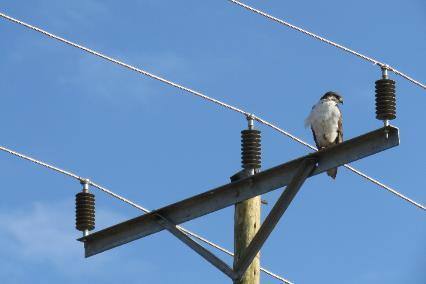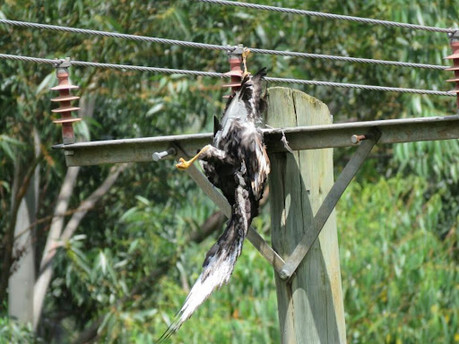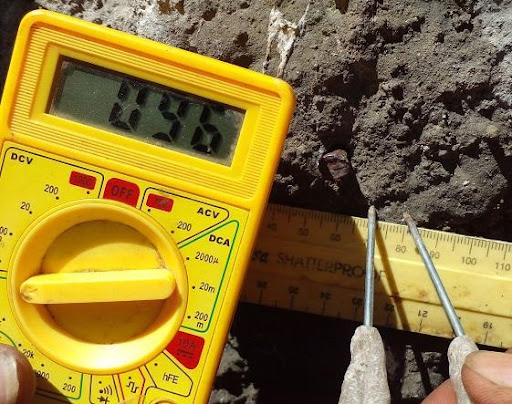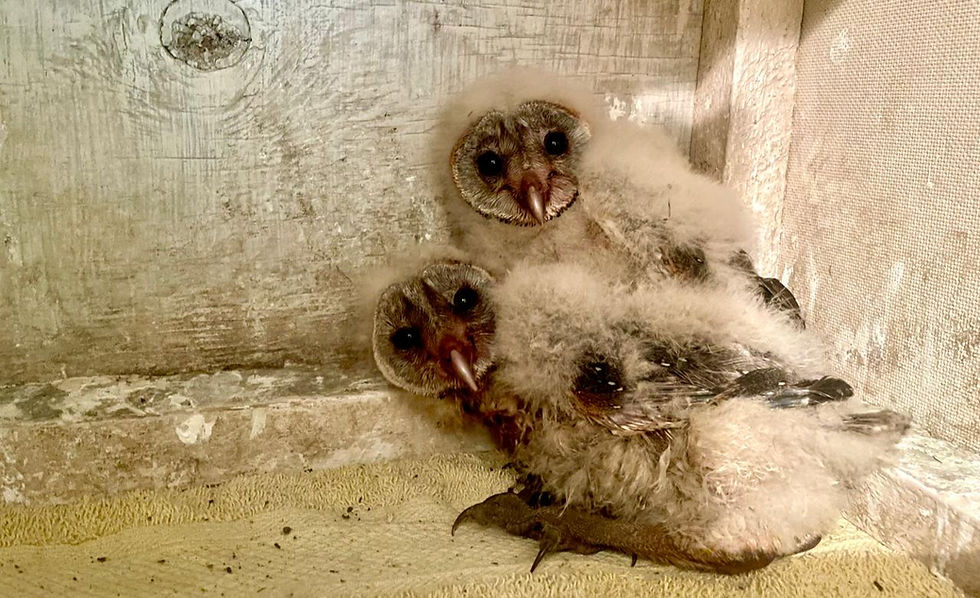How electric alternating current on overhead transmission wires kills raptors in very large numbers
- Simon Thomsett

- May 31, 2022
- 16 min read
The issue of electrocution of threatened and endangered raptors is a rapidly growing problem across much of Africa and the “developing” world. The onus is on development and industrialisation designed to cope with a very high human growth demographic. Because Africa and other developing nations are not financially rich this may result in cost cutting options that result in minimal tangible safeguards to ensure “safe” powerline configurations that do not kill raptors. The truth is that we can have safe power without electrocuting a single bird for the same cost. And less electrocuted birds means a steadier power supply which means less costs and more reliable power.
Africa has one huge advantage, the ability to leapfrog sequential development evolution, famously adopting, for example, cell phone technology without having to go through the processes of a land network. It placed Africa, and especially Kenya, at the forefront of cellphone technology overnight. We therefore have that rare commodity of hindsight, with many mistakes made elsewhere not having to be repeated at great cost. Electrocuting often critically endangered species is one of those unnecessary steps that we can leapfrog because others before us have learned it the hard way and have already developed safe solutions. The use of concrete, metal cross-arms, bare wire and short insulator power poles is therefore a retrograde technological embarrassment.
We refer specifically to raptors here but we are well familiar with the mortalities that occur with other birds, primates, giraffes and any animal capable of touching a live wire or climbing a pole. Originally Kenya power pole infrastructure was made of gum poles, wooden cross-arms, high insulators, that greatly reduced the incidence of electrocution. The “new” concrete pole, metal cross arm designs with shorter insulators present self-setting lethal traps for raptors especially and as a result incidences of electrocution and electric shock has skyrocketed. This has a great negative effect on raptor populations because raptors breed slowly, have large territories, and cannot rapidly recruit lost individuals in the same time that monkeys, leopards or even giraffes can.
Once common raptors suffer catastrophic declines
Raptors are one of the fastest declining groups of vertebrates on earth today. In Kenya recent publication shows that previously very common “perch hunting” raptors, the Long Crested Eagle and Augur Buzzard, have suffered catastrophic declines of 94% and 91% respectively, and the latter has suffered a 47% decline in territory occupancy around Lake Naivasha alone, during 1995–2014 period. If similar losses have occurred throughout their distribution, which is probable, these data are sufficient to up-list both the Long Crested Eagle and Augur Buzzard from Least Concern to Endangered on the IUCN Red list. It is certain they are endangered at the local level. As a co-author of this study and with a personal memory from the 1970s it is my belief that the main declines of these common perch hunting species occurred since the late 2010s. The same period the Kenya Rural Electrification Project 2030 vision commenced in infrastructural development but that is perhaps co-incidental. The introduction of concrete poles with metal cross arms and short insulators became evident during the late 2010s in many new locations replacing safer wooden poles.

Some raptor species are specialist perch hunters. They require exposed perches within their territory on which to rest, hunt and maintain vigil over their territory. It is an energy saving strategy vital to their daily lives. They prefer dead branches and the “T” shaped power lines placed across landscapes at 2 to 12m high are therefore exceptionally attractive. Almost custom made to fulfil their requirements, especially in landscapes where dead wood is felled for fire wood and few other perching locations of suitable height are available.
Examples of a perch hunter using a perfectly designed perching pole. In both cases poles are wood, a much safer material than concrete, but in rain the pole can conduct electricity. If the landing Augur buzzard on the left touched either bare wire with its wings it would have been electrocuted regardless of the pole material, like the one on the right side (Photo of dead Augur Buzzard by Alfred Koeche).
It is not superfluous to mention this behaviour in detail when discussing the propensity of raptors to be “lured” onto power-poles is real. Trappers and game keepers of old would place high poles in empty landscapes to catch or kill raptors as this habit is almost obligatory to all raptors. The poles therefore act like a lure, a perch so inviting and deadly that they can be termed a “sink”, killing many more individuals than otherwise predicted by their observed occurrence in the field.
Boy the Martial Eagle died of electrocution
In 2021 we had a first year male Martial Eagle called Boy that had been electrocuted on a conservancy on the North Lake Naivasha. His wrist, distal radius and ulna, and “hand” had been burnt, and the dying and living flesh eaten by maggots. The opposite foot had burns too and he lost his middle talon. All the primaries dropped off with all the tissue that held them together. It took a great deal of time to promote the living tissue over dead bone and form a skin to skin union. Months later he started to grow in new primaries, something almost impossible to do and we were very relieved that he would at least be able to move around an enclosure. He was not “out of the woods yet”, still requiring frequent wound cleansing and closure of flesh over open wounds. He was put aside as a possible future breeder and he settled into a daily routine among the other education birds until tragically he was suddenly overcome by maggots and bled copiously and died the next day. We have many similar electrocution cases with other raptors but when it is so glamorous and precious an eagle the news gets out. The numbers of Augur Buzzards we have with the same injuries caused by those same powerline designs doesn’t raise the same level of concern.
We watched the slow succession of chronic infections, myiasis, necrosis and osteomyelitis proceed without antibiotic therapies being sufficiently able to halt the progression. We spent considerable time and effort in trying to manage these issues and this highlights the probability of irresolvable infection and death of untreated but wounded, burnt “shocked” birds.
How does electrocution kill raptors?
Electrocution kills in a number of ways, first by disrupting and overheating the electrical pathways of the nerves and the brain, defibrillating the heart, causing tetanic contraction (inability to let go and thus muscles seize exasperating the situation), leading to dehydrated tissue and burning of soft muscle tissue as well as major organs. This can happen within one to 10 seconds. Direct current (DC) is much less dangerous, even at high Amps. It is the 50-60 cycles per second in alternating current (AC) that induces persistent contractions of all muscles and higher currents. Death is determined by the current, not the voltage. With regard to 11-32 KVA transmission lines or 120 KVA and above pylons, death is an inevitable outcome. Only when thin tissue makes one or more connections to the circuit does the animal stand a chance at surviving but only at the loss of that tissue. In most cases the loss of one or more limbs. None of this is novel information, there are literally thousands of publications all over the world about this issue. But here we highlight the ability of a raptor that has received so high a current as to guarantee killing limbs and feet, to fly away and to die, unconnected to the scene where it received its lethal wound.
The syntax difference between “Electrocuted” and “Shocked”
The term electrocution comes from “electricity” and “execution”. Technically those working on electric shock and electrocution are very careful to separate the two terms. In our opinion this is misleading in the context of raptors when both result in death. While an electric shock takes time to cause the "execution", the end result is the same. There is almost no situation conceivable where a raptor landing on an 11-32KV power line and making a short circuit of that massive current is going to receive just a “disciplinary” electric shock. One that warns it against landing there again such as would a sheep enclosure electric fence. It is either dead or has received life threatening injuries. If any do survive in the wild without treatment they are the absolute minority and there is little to suggest that they have the learning capacity not to repeat the action of landing on a live power line again. Thus the subtlety between electric shock and electrocution caused by 11-32KV power poles does not have much distinction in the end because both cause death.
The image below shows standard hazard signs. The top left zig zag spark going through a skull and crossbones indicates immediate lethal electrocution which equals death. This is what is counted by those doing studies on the effects of electrocution on raptors. Below it the hand denotes an electric shock. It is non lethal, the kind almost all of us have had from some faulty household appliance or electric fence. But for birds shocked on a 10-32KV power pole it is only a matter of time until it too equals death. The Tawny Eagle lying dead under both pylons and power lines died in the heart of a conservancy dedicated to bird conservation, of electrocution on a new concrete power pole.

Electrical conductivity of a bird’s body
I have attended a number of workshops on electrocution to be reminded by even senior suppliers of electricity that birds cannot be electrocuted. They give evidence of birds sitting on powerlines. A Youtube search for “Why do birds get electrocuted”, brings up “why birds do not get electrocuted” on power lines. Little wonder therefore that lethal power distribution lines continue to be erected even in protected areas if they are believed to be safe.
The fact that birds do get killed by electrocution is well reported in Kenya, especially when a migrant ringed stork gets killed or a town’s electricity is put out. This may be assumed to be a freak occurrence, not an accident waiting to happen, not as we shall learn as an absolute certainty.
Birds have as an extremity to their limbs very thin structures - the thin toes at the end of their legs and thin feathers at the end of their wings. The talons, toes, foot and leg we see are all made of toe bones (the metatarsus or tarsus which looks like a shin bone above the foot, is made of 3 fused digits). The drumstick of a chicken (on the tibiotarsus or tibia) is the muscle mass that powers the leg, foot, toes and claws and lies close to the body usually out of sight. The drumstick is much thicker than the thin tarsus and toe bones. The thicker and more hydrated the mass the more electricity it can conduct, the greater the Amps it can carry Blood has haemoglobin (iron and water) and conducts electricity very well. The tips of the hands (metacarpus) and the tarsus and toes have few blood vessels leaving them poorly supplied with circulation which means they don’t conduct electricity very well.
Below is a conceptual electric circuit schematic of a bird, showing lines denoting the various amounts of Amps a bird body can conduct before burning and cutting the circuit. We are familiar with 30 Amp and 5 Amp fuses, and we know that the lesser Amp fuse will burn out before the higher Amp fuse. A fuse literally explodes and burns in a microsecond cutting the passing of electrons. Much the same happens when a bird foot burns. It immediately evaporates the water (a good conductor), burns out the haemoglobin channel (the blood vessels) and breaks the circuit. To visually affirm the “fuse-like” analogy, after the passage of a high voltage through the vessels in the tarsus we often see blackened charcoaled tunnels lying precisely where the vessels were. Eerily the foot still works, because the drumstick behind it is alive (saved by the 5 Amp fuse), pulling tendons as normal making the foot open and close.

Fuses are used to protect electrical appliances and are made of metal wire and are physically thick (high Amp) or thin (low Amp), protecting the electrical appliance. This parallels for illustration sake, the body core and major muscle mass areas of a bird (the main electrical appliance) and the thin less Ampere conductivity of the distal parts such as the wing and foot tips.
The objective of the exercise is to envisage the internal organs and brain of a bird and the fuses that protect this core. Looking at the “stick figure” bird diagram if contact is made 30 Amp to 30 Amp (Say wing to wing, wing to thigh, thigh to head) a lethal amount of electricity goes through the internal organs and the brain and the bird dies immediately. If, contact is made with toes, foot or tarsus, or alula or carpal “fingertips” (all thin distal parts with minimal blood flow and tissue), the “5 Amp” fuse blows before the 30 Amp and the bird can receive an otherwise lethal current saved by this low Amp fuse. This low Amp fuse circuit breaker may save its life, and in many cases it can fly or walk away. We can place this stick figure caricature in various animated positions on a hypothetical power pole design and work out statistically the chances of 5 Amp or 30 Amp short circuits.
The chance of getting electrocuted or shocked
We need to understand the chances of the bird's contact points touching the metal cross-arm, centre pole top (earth), or 2 of the three “live” phase wires and the amount of current passing through them. In order to get an idea of the percentage of birds being electrocuted or “shocked” we need to know measurements of the bird and the measurements of the various components of the pole, insulators, cross arm, etc.
Damp concrete
If anyone was brave enough they could put a voltmeter with one terminal on the metal cross arm and the other terminal on the top of the concrete pole, they may be surprised to know that this conducts electricity. Even a 9 v battery tester will pass nearly 9v through 1cm of damp concrete, enough to light a LED bulb. Below on the left shows a voltmeter with a 9 v, showing above on the left a 1000Ω resistance on 1cm of dry concrete. On the right on damp concrete (wetted 5 minutes previously and not soaked) there is about a 100Ω resistance. This is insignificant resistance to 11-32 KVA able to arc directly through the concrete covering.
Steel reinforcing rods
Below the top of a concrete pole showing naked reinforcing rods. In a sample reference, 17 out of 87 of concrete pole tops on Namanga to Amboseli road had exposed rods prior to being erected. Those that were capped had an estimated distance from the capped concrete to metal rod less than 1cm with most having visible tips where the trowel that topped the concrete top had touched the end rod. Those poles (n=7) observed broken after one year standing had signs of rust entering the top concrete…in places showing obvious ferrous reddening of a rod less than a few mm beneath. A study by electricians would certainly reveal the high hazard level of these poles to perching birds.

Dangerous designs
This illustration shows a concrete pole, exposed metal reinforcing rods, low insulators, bare cable and distances easily connected by a perched bird or landing bird. The KVA carrying capacity in theory can be estimated by the number of insulating disks (with 7-10 thousand volts per ring), but we regularly see alternate poles carrying 2, 3, 4, to 8 disks on the same lines.

The bottom left photograph shows a particularly dangerous design. The bottom “Alpha” design is also very dangerous with an extended negative top wire decreasing the gap down a large section of the pole.
NB the middle and right photo show that the negative top line on an Alpha design is tied directly to the metal arm and not to the insulator. Poor workmanship is certainly a contributory factor in raising mortality rates.
Feathers are poor conductors thus birds are safe
To confuse matters, reference is often made to the non conductivity of feathers, made of keratin. The long flight feathers are made of keratin and like plastic are very good insulators and thus poor conductors of electricity. So when primary tips touch a live wire the chances of causing a short circuit are minimal, below say some 10,000 volts at a low Amps (below 0.5 Amps), often not enough to kill or cripple. Above this voltage some flashover is expected, how much depends upon the density of the feathers, the proximity to the limbs and flesh and crucially how damp they are. High humidity or recent drizzle or rain greatly increases conductivity making the primaries and all feathers conductive. A “flashover” can arc across air gaps as much as 5-10cm thus explaining why 10-32KV insulators are so long (some are over 35 cm long). Any shorter the air gap and an arc can occur. A bird foot or wing doesn’t have to make direct contact therefore for a short circuit to occur if it enters this minimal air gap. While we do see flashover electrocutions across long flight feathers, the majority of short circuits on the wing occur on the inside hand and fingers, the metacarpals.
If we superimpose various sized raptors in the act of landing on various power pole configurations we can see the chances of making a closed circuit across fleshy tissue is high. Birds always land with their feet and extended wings in a flare out position that happens to coincide (for medium to large birds) with the positions of “live” contact points of many power pole designs. (Not all power pole designs…remember this for it is vitally important). See below as an example of a safe pole design that does not need expensive retro-fitting options.

Safe configurations are available in terms of cross arm distancing themselves from short circuits and almost all other retro-fitting options are “boots’ that encase thick non conductive “cap” insulators or have plastic “tubes” covering bare live sections. These may include 1m or more plastic/silicone/rubber sheathes over wires that traverse the insulator grove, caps over the grove connection, or elbows that covered jumper sections etc. There are hundreds of options varying greatly in price and efficiency.
It is easy to imagine how a 2 to 3m wing span plus a 1.5 m extended foot of a large eagle can bridge wires but this male Martial Eagle foot span is 21cm and alone can bridge cross arm to live wire gaps on the centre pole. The eagle foot is bigger than an average human hand and the length of the leg is almost as long as a human arm. The wing span is of course much larger than a human arm span.

Large and medium sized raptors most at risk
We see that a medium sized raptor such as an Augur Buzzard can easily contact live wires with negative earth areas on most power poles, especially the new concrete/metal cross arm/ short insulator/naked wire poles. Large raptors too can make contact as easily but with different parts of their body, across different parts of the electrical “cats cradle” of wires and conductors. Much work has been done on Golden Eagles that are in terms of size similar to our Martial, Verreaux’s, Crowned, Tawny, Gyps vultures and Lappet, White faced, Hooded Vultures. A recent paper showing the failure of some mitigation actions by Dwyer illustrates the enormous potential of electrocutions even on “safe” retrofitted poles that in retrospect were evidently poorly constructed and/or conceived. In this paper they give rates ranging from “Great Risk pole” to “Least Risk pole”. Starting from no mitigation (very high risk, the same as Kenya’s poles), through to a “redirection fitment poles” (a series of upright pins that dissuade birds from landing), through to insulated capped tops to finally live wire distances that exceed 3m between each phase. Although these are not exactly replicable to our situation or concerns because they mostly use wooden poles and focus on Golden Eagles not raptors in general, what is clear is that large and medium sized raptors are at very high risk.
Avian electrocution risk is highest on poles with no mitigation, and lowest on poles with avian-friendly retrofitting achieved through insulation or separation. Source: Avian Electrocutions on Incorrectly Retrofitted Power Poles, DwyerJ.F., Harness,R.E., Eccleston.D., Journal of Raptor Research (2017) 51 (3): 293-304.
Electrocution threat scale
On different sized raptors that have been electrocuted we see a slight difference in burn placement. Small raptors such as kestrels can miss making short circuit contact on most power pole configurations except those with very short insulators such as the two disk very short insulator. Some raptor species such as the accipiters are not given to perching on exposed open perches and are less likely to be electrocuted.

There is room for a species by species electrocution threat scale. For example, we know that both the Eastern and Dark Chanting goshawks are a group very likely to be killed by electrocution by their habit of perching on these poles and being just the right size to make contact… although our data does not indicate it. Possible reason for this is the lack of individuals in the drier landscapes most likely to record mortalities and the lack of ornithologists and regular counts in these regions. Other species such as Lizard Buzzards, Shikra, Pygmy Falcons and Black-shouldered Kites tend to perch like doves on a single line and thus escape electrocution. Nonetheless we can make a high to low risk categorisation of Kenyan raptors.
Taking all the variables into account we can see that 75-90% of all contacts are predicted to be through the 5 Amp distal parts of medium/large sized raptors. We can also hazard a guess at how many landings or take offs are needed to make that short circuit, by watching their landings and take offs, turning, feeding, even mating or fighting on these perches. Statistically the chances of making a short circuit are high. It becomes only a matter of time until they make a short circuit.
We can test the above with slow motion photography if anyone doubts the logic. We could today use computer generated imagery (CMI) that shows conductivity in terms of ohms, the current that can pass through the path of least resistance, the low and high amp “fuse” areas of the body and make models from this virtual reality imagery that show chances of mortality for every species. It would be very disturbing no doubt.
Slow motion photography is not a new idea, it was filmed in slow motion over half a century ago by Morley Nelson (using trained raptors on dummy poles). The potential for electrocution of various sized poles has long been studied and safe options emerged from these studies nearly three quarters of a century ago. It is unacceptable therefore that Kenya opted for one of the most potentially lethal of all pole configurations and that the donor bodies, Schedule 6 criterion, EIA consultants and contractors allowed it. Remember, many of our raptor species are Critically Endangered already. This only adds to their precipitous decline.
By explaining how potentially lethal power lines are from an electrician's point of view we can circumvent the often tedious and inherently flawed observations needed by biologists of actual mortalities. The task of the biologist is to witness deaths and enumerate them and weigh this against the total population of the species, when in actuality they will never be able to get that data. They inherently overlook what we here argue is the main bulk of casualties - those birds that blow their 5 Amp fuses.
Bacterial growth and myiasis as contributory factors in raised mortality in the tropics
The blow of a 5 Amp fuse causes flesh to die. Any dead flesh in the tropics attracts flies and thus maggots. What may have started as a superficial wound may end up torn to shreds by the bird in a desperate attempt to rid itself of the pests. Flies bring bacteria too, which in warm tropical environments may proliferate at faster pace than in colder temperate environments. This is an important contributory factor in evaluating overall electrocution mortality in the tropics from what may be superficial wounds.
Safe options are available
As said, the potential for electrocution of various sized poles has long been studied and safe options emerged from these studies. It is unacceptable therefore that Kenya opted for one of the most potentially lethal of all pole configurations. If you care for #birdsafepowerpoleskenya, please sign this petition to The Kenya Power and Lighting Company, explaining the problem and asking them to insure safe wire configurations so that our birds and all other wildlife can be safe.
To be continued
In our next blog we go over the long and procreated death of a male and female Martial Eagle that literally disintegrated from electrocution damage. We show a novel technique using thermal imagery in determining dead tissue from live tissue as well as the challenges facing us in getting the data required to enforce change in the power distribution industry.
Wish to learn more, visit our website and join us on Facebook and Instagram.
Kenya Bird of Prey Trust
Understand - Protect - Restore




























This is tragic. However, the article is too long on physical detail of how birds are killed by powerlines and doesn't seem to offer any solutions, and what if anything is being done to prevent bird electrocutions in Kenya and wider Africa.